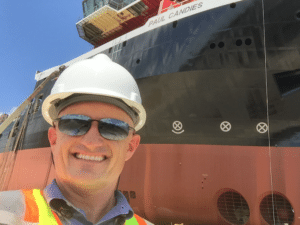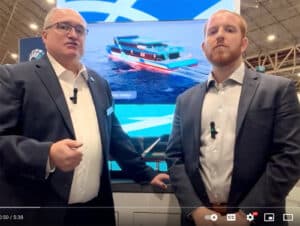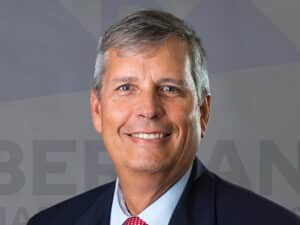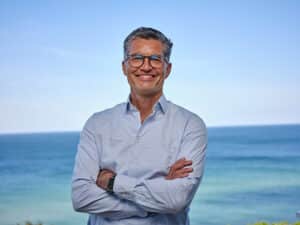
10 minutes with Ard-Jan Kooren, President & CEO of KOTUG International
Written by Heather Ervin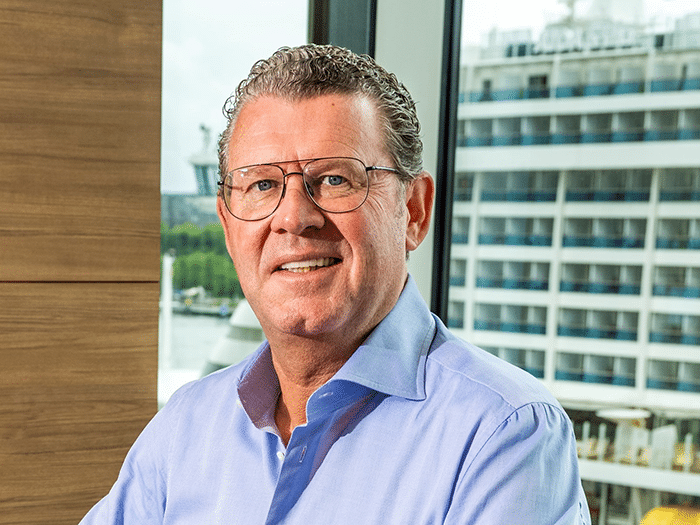
Ard-Jan Kooren
Kotug International, based in Rotterdam, has provided towage and related services to the maritime industry for years. Leading that family owned business is Ard-Jan Kooren, who joined Kotug in 1990 as an operations employee and worked his way up in 2002 to the rank of CEO, a role his father held before him.
Over the last year or so, the company has worked on some interesting, cutting-edge projects to include a zero-emissions barging solution and an e-pusher tug. We dive more into this and other important news coming out of Kotug in the exclusive interview with Kooren.
Marine Log (ML): First, can you tell us more about Kotug and its place in the maritime industry?
Ard-Jan Kooren (AJK): With roots going back as far as 1911, Kotug is a family-owned company and trusted voice and partner of leading companies within the worldwide maritime industry, offering a broad range of innovative towage and maritime-related services. Kotug has always been committed to taking a leading role in the transition towards sustainable and safe maritime solutions. From the design and construction of the revolutionary Rotortug, to the first hybrid tug under class. In 2018, Kotug was the first company in the world to remotely operate a tugboat. Adding value through sustainability-focused innovations, Kotug provides a complete portfolio of services based on a combination of long-standing knowledge and advanced technologies. From designing, building, chartering and operating vessels to training people and providing innovative consultancy services. We are active in Europe, Asia, Australia, Africa, the Middle East, North and South America and the Caribbean and continue to expand our operations worldwide.
Since 2021, Kotug has been active in inland shipping with the introduction of the unique Kotug E-Pusher Series, a range of modular and scalable electric pusher tugs (Small, Medium and Large) powered by swappable energy containers, including a smart AI-driven dispatch and route planning application. With this zero-emission logistic solution, Kotug aims to support the worldwide energy transition and the modal shift from road transport to waterways while meeting the growing demand for electric-powered vessels. With the E-Pusher we offer a solution that is not hung on one energy source; the swappable energy container can easily switch from batteries to stage V diesel to hydrogen etc. This enables a complete zero emission set up but also a gradual shift to completely zero emission transportation in time. With the E-Pusher, Kotug supports companies that want to build more resilient and sustainable supply chains.
The E-Pusher S, also known as CityBarge, has already become a proven concept for silent and emission-free commercial transportation of (construction) waste and construction materials in several cities in the Netherlands. It is the answer to the severe restrictions of heavy transport in inner cities and the worldwide trend to build liveable and green cities. As we speak, the Kotug E-Pusher type M is being assembled in Rotterdam.
ML: It was announced earlier this year that Kotug is working with a third party to provide a zero-emissions barging solution for Cargill. Can you tell us more about this project and where it is in development?
AJK: KOTUG will deploy the KOTUG E-Pusher type M and four electrified barges for zero-emission barging of cocoa beans from Cargill between the Port of Amsterdam, the largest cocoa import port in the world, and their cocoa facilities in Zaandam. Cargill will be the first company in the world with this fully electrified industrial setup for inland shipping. The swappable battery energy containers will come from a third party.
The E-Pusher is modularly built, which is different from traditional shipbuilding. The design consists of a frame, a patented & recyclable floating body, a propulsion system, a containerized energy source, and accommodation. The parts are ordered/built simultaneously by carefully selected suppliers, brought together to one location, and assembled into one vessel. Altogether, this lean process results in significantly lower costs (-25%) and shorter delivery times. Parts can be replaced easily, and the design can easily be changed per vessel. Finally, the E-Pusher is fully recyclable and doesn’t need antifouling.
ML: In May, Kotug and the Seamen’s Church Institute here in the U.S. partnered to offer maritime training across the United States. How did this partnership come to be and what sort of training are you offering together?
AJK: Kotug is firmly committed to the highest industry standards of health, safety, environment, quality and security. With ports and vessels growing bigger and bigger, safety and the adequate deployment of assets have become a risk for safe and efficient operations. Back in 2000, Kotug started offering a high-quality training system. We believe extensive training and simulation are the key solutions to mitigating these risks. Why? Because we see in our daily operations how captains that are only trained on the job significantly reduce the capacity and potential of the assets they work with. This is often, and very unfortunately, due to ignorance, leading to unsafe an inefficient operations that also endangers the environment.
Our comprehensive tug master training is a potent combination of knowledge, theory and practice. Delivered by experienced tug masters with first-hand expertise across the full range of tug types, our methods are based on in-depth tug operation knowledge combined with extensive towage experience in all conditions and environments. Because a new type of tug influences maneuvering procedures on board ships, influencing a pilot’s job, we also offer joint pilot and captain training. Comprising the total procedure of ship handling based on the new type of tug and its capabilities and limitations, taking into account port characteristics, ships calling at the port and environmental conditions.
Training takes place in simulator centers across the globe, in classrooms and live on real ships. Since 2019, Seamen’s Church Institute (SCI), Riben Marine, and Kotug have performed training for ship pilots and tug masters—-prior to conducting feasibility studies for new docks and waterway projects–along the Texas Gulf Coast. As a logical next step, this year, Kotug entered into a strategic partnership to offer exclusive training of (tug) masters, ships’ crews, river barge shippers, and pilots by certified Kotug trainers at SCI training facilities across the United States.
In May this year, this partnership came together during the first Basic Azimuth Stern Drive (ASD) Tug Class for Moran Towing Corporation, among the largest tow and tug fleet operations in the United States. SCI also uses Kotug’s unique assessment app, allowing them to objectively measure the success of their training in support of their drive to deliver the highest training standards to their customers. Not only the app measures the effectiveness of the training, but it also generates a detailed reporting suite.
ML: Do you provide or offer other services to the U.S.?
AJK: The company’s expertise is divided across a number of related pillars:
- Towage (Harbour, Offshore and Terminal Towage, Inland Towage, Chartering and Salvage);
- Training and Consultancy, Intelligence (OptiPort, Analytics and Reporting, Drone Line Transfer);
- Subsea (SPM Operations and Maintenance, Asset Integrity Management); and
- Maritime Excellence (Ship Management, Innovations, Projects & New Building, Fast Crew Transportation).
We have several clients across the U.S. who use Kotug OptiPort; our Artificial Intelligence-based planning tool. OptiPort unlocks operational capacity by smarter planning, leading to asset optimisation and more sustainable operations over the entire nautical value chain, by significantly reducing fuel consumption of the tugs and other nautical assets. From tug scheduling to port activity reporting, crew planning, port optimisation and inland towage. Lastly, our expert advice can be applied to all situations involving tugs, from designing port and terminal layouts to determining procedures for sustainable waterborne transport projects.
In addition, we have a partnership with Seabulk Maritime, Kotug Seabulk Maritime. In this partnership we deploy four tugboats, a line handler, a crew tender launch and a bunker barge to execute all terminal towage operations, including bunker barge assistance for Buckeye Partners, L.P. at their Buckeye Bahamas Hub in Freeport Bahamas.
ML: Finally, can you tell us more about your milestone projects that came online this year and what can we expect from Kotug in 2023?
AJK: An absolute highlight this year was the acquisition of Seaways International in September. Seaways was a reputable owner and operator of state-of-the-art Offshore Support Vessels providing offshore marine services to the global energy industry. The acquisition is an important milestone for Kotug to strengthen our leading position in global offshore markets and is part of Kotug’s strategy to expand its business in assisting worldwide floating facilities such as FSO, FPSO, FLNG, FSRU and SPM Terminals.
In 2023, we will continue to focus on supporting our clients in making their operations more sustainable with new products and services and improving our existing services. For instance, the Kotug Drone Line Transfer, using a drone to connect the towline to an assisted vessel—drastically improves the safety margin of tug operations as this avoids the need for manoeuvring in the so-called danger zone. Furthermore, we will focus on rolling out the E-Pusher and further consolidate the leading position of Kotug in global offshore markets after the acquisition of Dubai-based Seaways International.


